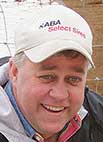
Carol and David Dunbar began their Chocolate Horse Farm with imported horses
It was spring in the rolling countryside of Yeovil, England, when Carol and David Dunbar discovered their new life’s passion.
What Carol first spotted wandering behind bright, green hedgerows quite literally stopped her in her tracks.
Carol was on her daily trek to a local coffee shop, when she pulled over and got out of her car. She walked to the edge of the hedgerow to get a closer look at what had captivated her attention.
Much to her surprise, the object of her inquiry was just as interested in her – and it came to the fence to greet her.
“I have been around horses my entire life and I have never had horses unfamiliar to me – just walk up to me,” Carol said, reflecting on that day in 2000.
These horses were nothing like any Carol had ever seen. The animals had abundant feathering from their knees and hocks covering their hooves, plus long, flowing manes and tails. The broad-chested, draft-bodied horses were a rich, brown color and stood 13 to 15 hands tall. “I was fascinated. I took pictures and showed them to David,” Carol recalled.
While answering an ad for a horse drawn carriage, Carol and David met up with the horses once again.
“A lorry pulled into the yard and dropped a tailgate and about 15 of these horses sauntered off of this ramp and milled around in this big enclosed area. I am sure my mouth was open,” Carol said. “That was the beginning of what you see here.”
A year later, as the Dunbars were preparing to return to the United States, they were determined to bring a few of these horses with them and imported three, two colts and a filly to start their herd.
After four-years in New York with their horses, the Dunbars purchased a 50-acre farm in Mount Vernon, Mo. Friends living in Buffalo, Mo., encouraged the Dunbars to check out the Ozarks, and Chocolate Horse Farm is now home to 21 horses, and Annie the mule.
The Dunbars named their operation Chocolate Horse Farm to capture their two loves – horses and chocolate – in one name.
“David makes the best fudge in the whole world,” Carol said with a grin.
“We want people to know that this is an exceptional horse, well trained it is perfect for the beginner any many make perfect therapy mounts,” Carol explained. “Our goal is to match horse and owner as well as we can based on the horses talents and the owners experience level.”
According to the Gypsy Vanner Horse Society, Gypsies in Great Britain spent decades breeding horses to create an animal perfect for pulling their caravans. In 1996, the first Gypsy Vanner horses were imported to the United States. The breed was given the name Gyspy Vanner because the horses were originally a Gypsy’s “vanner horse,” bred to pull Gypsies’ cara”vans”.
The Gyspy Vanners are derived from the Shire, the Clydesdale, Fells and Dales ponies. They vary greatly in color and can be solid, tobiano or splash.
“This is an exceptionally smart animal, a quick study. It learns faster than any of the Quarter horses or Arabs I have ever worked with,” Carol explained. “It really wants to please you.”
Chocolate Horse Farm has been taking its Gypsy horses to expos, shows and equine fairs for the past 15 years. The Dunbars primarily train their Gypsy Vanners to drive as they were bred to do; however, they add, this particular breed of horse is quite versatile. Breeders train Gypsy Vanners to drive carts and carriages, perform in a dressage ring, or take riders on trail rides.
At Chocolate Horse Farm, the Dunbars spend countless hours working with their horses before they ever put a full harness or saddle on them.
“We have found this method works best for us,” Carol added.
During the past two years, medical concerns have brought about new challenges in the Dunbars lives and have necessitated the help of a trainer. They are grateful to have their beloved horses to help lift their spirits during this difficult time.





